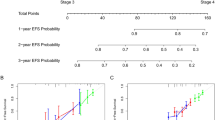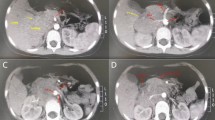Abstract
This study aimed to confirm the independent risk factors for recurrence-free survival (RFS) in intermediate and high-risk neuroblastoma (NB) patients and set up an effective nomogram model for predicting the recurrence of NB. A total of 212 children with intermediate- and high-risk neuroblastoma, who had ever achieved complete remission (CR) or very good partial remission (VGPR) after standardized treatment in this hospital, were chosen as study objects. After retrospective analysis of the clinical data, Cox regression model was used to explore the factors related to the recurrence of neuroblastoma, to determine the variables to construct the Nomogram. The consistency index would predict the accuracy of this nomogram. RFS rate in 1-year, 3-year, 5-year, and 10-year was 0.811, 0.662, 0.639, and 0.604, respectively. Children with MYCN amplification had a higher neuron-specific enolase (NSE) value (P = 0.031) at the initial diagnosis than MYCN non-amplification. The univariate analysis predicted that increased vanillylmandelic acid (VMA) and NSE value and dehydrogenase (LDH) > 1000 U/L were important adverse factors for the recurrence of NB. Multivariate analysis demonstrated that age at diagnosis, tumor localization, MYCN state, histologic subtype, and tumor capsule were significantly associated with RFS (all P values < 0.05). Nomograms were established for predicting the recurrence of NB according to the Cox regression analysis. Internal verification by the Bootstrap method showed that the prediction of the nomogram’s consistency index (C-index) was 0.824 (P = 0.023).
Conclusion: Age at diagnosis, tumor localization, MYCN state, histologic category, and tumor capsule were independent risk factors for the recurrence of NB. The nomogram model could accurately predict the recurrence of children with neuroblastoma.
What is Known: • The prognoses of neuroblastoma (NB) could vary greatly due to the high heterogeneity, the 5-year survival rate of low-risk NB exceeded 90%, while the 5-year survival rate of children in the intermediate and high-risk groups was not satisfactory.. | |
What is New: • Increased vanillylmandelic acid (VMA) and neuron-specific enolase (NSE) value, and lactate dehydrogenase (LDH)>1000U/L were important adverse factors for the recurrence of NB. • NSE value was more valuable for predicting NB recurrence. |




Similar content being viewed by others
References
Tsubota S, Kadomatsu K (2018) Origin and initiation mechanisms of neuroblastoma. Cell Tissue Res 372(2):211–221
Whittle SB, Smith V, Doherty E, Zhao S, McCarty S, Zage PE (2017) Overview and recent advances in the treatment of neuroblastoma. Expert Rev Anticancer Ther 17(4):369–386
Maris JM (2010) Recent advances in neuroblastoma. N Engl J Med 362(23):2202–2211
Swift CC, Eklund MJ, Kraveka JM, Alazraki AL (2018) Updates in diagnosis, management, and treatment of neuroblastoma. Radiographics 38(2):566–580
Ward E, DeSantis C, Robbins A, Kohler B, Jemal A (2014) Childhood and adolescent cancer statistics, 2014. CA Cancer J Clin 64(2):83–103
Olsen HE, Campbell K, Bagatell R, DuBois SG (2020) Trends in conditional survival and predictors of late death in neuroblastoma. Pediatr Blood Cancer 67(10):e28329
London WB, Castel V, Monclair T, Ambros PF, Pearson AD, Cohn SL et al (2011) Clinical and biologic features predictive of survival after relapse of neuroblastoma: a report from the International Neuroblastoma Risk Group project. J Clin Oncol 29(24):3286–3292
Brodeur GM, Pritchard J, Berthold F, Carlsen NL, Castel V, Castelberry RP et al (1993) Revisions of the international criteria for neuroblastoma diagnosis, staging, and response to treatment. J Clin Oncol 11(8):1466–1477
Kushner BH, Kramer K, Modak S, Cheung NK (2009) Sensitivity of surveillance studies for detecting asymptomatic and unsuspected relapse of high-risk neuroblastoma. J Clin Oncol 27(7):1041–1046
Su Y, Ma XL, Wang HM, Qin H, Qin MQ, Zhang FQ et al (2020) Clinical characteristics and prognostic analysis of 458 children with high-risk neuroblastoma in a single center. Zhonghua Er Ke Za Zhi 58(10):796–801
Chang HH, Lu MY, Yang YL, Chou SW, Lin DT, Lin KH et al (2020) The prognostic roles of and correlation between ALK and MYCN protein expression in neuroblastoma. J Clin Pathol 73(3):154–161
Iasonos A, Schrag D, Raj GV, Panageas KS (2008) How to build and interpret a nomogram for cancer prognosis. J Clin Oncol 26(8):1364–1370
Balachandran VP, Gonen M, Smith JJ, DeMatteo RP (2015) Nomograms in oncology: more than meets the eye. Lancet Oncol 16(4):e173–e180
Kim SY, Yoon MJ, Park YI, Kim MJ, Nam BH, Park SR (2018) Nomograms predicting survival of patients with unresectable or metastatic gastric cancer who receive combination cytotoxic chemotherapy as first-line treatment. Gastric Cancer 21(3):453–463
Wang J, Yang B, Li Z, Qu J, Liu J, Song N et al (2020) Nomogram-based prediction of survival in unresectable or metastatic gastric cancer patients with good performance status who received first-line chemotherapy. Ann Transl Med 8(6):311
Shimada H, Ambros IM, Dehner LP, Hata J, Joshi VV, Roald B et al (1999) The International Neuroblastoma Pathology Classification (the Shimada system). Cancer 86(2):364–372
Peuchmaur M, d’Amore ES, Joshi VV, Hata J, Roald B, Dehner LP et al (2003) Revision of the International Neuroblastoma Pathology Classification: confirmation of favorable and unfavorable prognostic subsets in ganglioneuroblastoma, nodular. Cancer 98(10):2274–2281
Wang Y, Wu Y, Wang L, Yuan X, Jiang M, Li Y (2017) Analysis of Recurrent sacrococcygeal teratoma in children: clinical features, relapse risks, and anorectal functional sequelae. Med Sci Monit 23:17–23
Wu ZY, Shen W, Yue JQ, Yao WY, Liu SL, Jin YP et al (2020) Combining immunoscore with clinicopathologic features in cholangiocarcinoma: an influential prognostic nomogram. Onco Targets Ther 13:11359–11376
Garaventa A, Parodi S, De Bernardi B, Dau D, Manzitti C, Conte M et al (2009) Outcome of children with neuroblastoma after progression or relapse. A retrospective study of the Italian neuroblastoma registry. Eur J Cancer 45(16):2835–42
Lee JW, Son MH, Cho HW, Ma YE, Yoo KH, Sung KW et al (2018) Clinical significance of MYCN amplification in patients with high-risk neuroblastoma. Pediatr Blood Cancer 65(10):e27257
Nakazawa A, Haga C, Ohira M, Okita H, Kamijo T, Nakagawara A (2015) Correlation between the International Neuroblastoma Pathology Classification and genomic signature in neuroblastoma. Cancer Sci 106(6):766–771
Sokol E, Desai AV, Applebaum MA, Valteau-Couanet D, Park JR, Pearson ADJ et al (2020) Age, diagnostic category, tumor grade, and Mitosis-Karyorrhexis Index are independently prognostic in neuroblastoma: an INRG Project. J Clin Oncol 38(17):1906–1918
Li YZ, Liu YW, Wang SC, Tai J, Zhang J, Liu YH et al (2019) Clinical analysis of head and neck neurogenic tumor in childhood. Lin Chung Er Bi Yan Hou Tou Jing Wai Ke Za Zhi 33(10):983–986
Parodi S, Papio F, Haupt R, Conte M, De Bernardi B (2007) The prognostic role of urinary catecholamines in infants with disseminated neuroblastoma might be mediated by MYCN amplification. Pediatr Blood Cancer 48(5):593; author reply -4
Strenger V, Kerbl R, Dornbusch HJ, Ladenstein R, Ambros PF, Ambros IM et al (2007) Diagnostic and prognostic impact of urinary catecholamines in neuroblastoma patients. Pediatr Blood Cancer 48(5):504–509
Cangemi G, Reggiardo G, Barco S, Barbagallo L, Conte M, D’Angelo P et al (2012) Prognostic value of ferritin, neuron-specific enolase, lactate dehydrogenase, and urinary and plasmatic catecholamine metabolites in children with neuroblastoma. Onco Targets Ther 5:417–423
Monclair T, Brodeur GM, Ambros PF, Brisse HJ, Cecchetto G, Holmes K et al (2009) The International Neuroblastoma Risk Group (INRG) staging system: an INRG Task Force report. J Clin Oncol 27(2):298–303
Brisse HJ, McCarville MB, Granata C, Krug KB, Wootton-Gorges SL, Kanegawa K et al (2011) Guidelines for imaging and staging of neuroblastic tumors: consensus report from the International Neuroblastoma Risk Group Project. Radiology 261(1):243–257
Cohn SL, Pearson AD, London WB, Monclair T, Ambros PF, Brodeur GM et al (2009) The International Neuroblastoma Risk Group (INRG) classification system: an INRG Task Force report. J Clin Oncol 27(2):289–297
Simon T, Hero B, Hunneman DH, Berthold F (2003) Tumour markers are poor predictors for relapse or progression in neuroblastoma. Eur J Cancer 39(13):1899–1903
Zeltzer PM, Marangos PJ, Parma AM, Sather H, Dalton A, Hammond D et al (1983) Raised neuron-specific enolase in serum of children with metastatic neuroblastoma. A report from the Children's Cancer Study Group. Lancet 2(8346):361–3
Liang SW, Chen G, Luo YG, Chen P, Gu JH, Xu QQ et al (2020) Nomogram for predicting overall survival in children with neuroblastoma based on SEER database. Ann Surg Treat Res 99(2):118–126
Acknowledgements
The authors wish to thank the patients and the staff in the Department of Pediatric Hematology/Oncology, Xinhua Hospital Affiliated to Medicine School of Shanghai Jiaotong University.
Author information
Authors and Affiliations
Contributions
All the authors contributed to the study conception and design. Data collection, follow-up, and analysis were performed by Quan Sun, Yanmin Chen, Qianya Jin, and Xiaojun Yuan. The first draft of the manuscript was written by Quan Sun, and all the authors commented on previous versions of the manuscript. All the authors read and approved the final manuscript.
Corresponding author
Ethics declarations
Ethics approval
The ethics approval was granted by the ethics committee of Xinhua Hospital Affiliated to Shanghai Jiao Tong University School of Medicine. This study was conducted in accordance with the principles of the Declaration of Helsinki.
Conflict of interest
The authors declare no competing interests.
Additional information
Communicated by Peter de Winter
Publisher's Note
Springer Nature remains neutral with regard to jurisdictional claims in published maps and institutional affiliations.
Rights and permissions
Springer Nature or its licensor holds exclusive rights to this article under a publishing agreement with the author(s) or other rightsholder(s); author self-archiving of the accepted manuscript version of this article is solely governed by the terms of such publishing agreement and applicable law.
About this article
Cite this article
Sun, Q., Chen, Y., Jin, Q. et al. A nomogram for predicting recurrence-free survival of intermediate and high-risk neuroblastoma. Eur J Pediatr 181, 4135–4147 (2022). https://doi.org/10.1007/s00431-022-04617-2
Received:
Revised:
Accepted:
Published:
Issue Date:
DOI: https://doi.org/10.1007/s00431-022-04617-2




